This website is supported by its readers. If you click one of my links I may earn a commission. I am also a participant in the Amazon affiliates program and I will also earn a commission from qualified purchases.
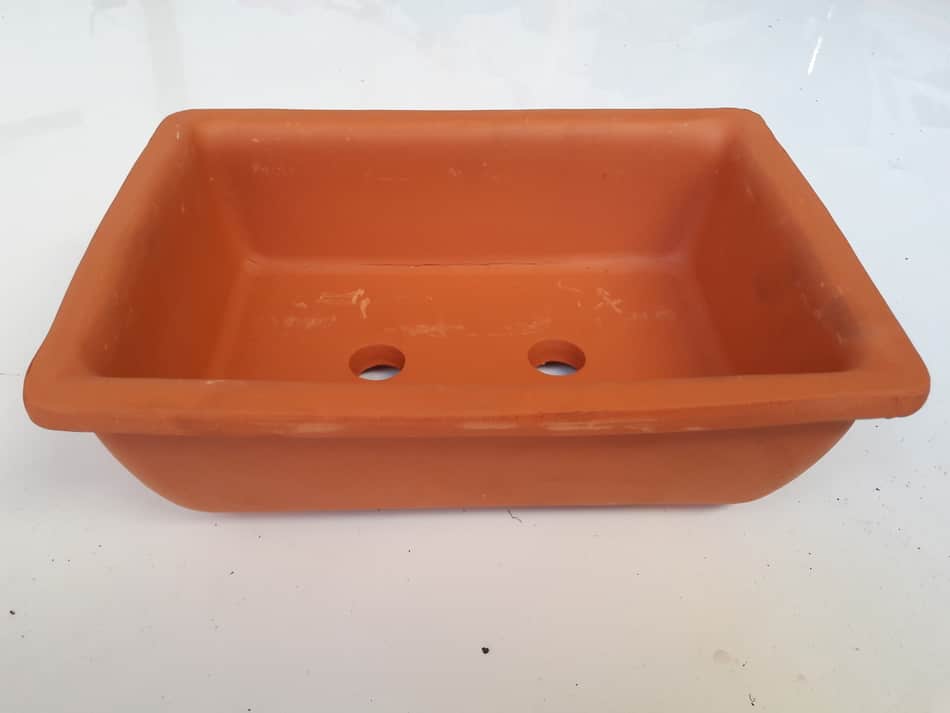
So a few days back I decided to buy a brand new four-year-old Chinese elm to add to my collection. Mainly to be used as my training tree. One of the things though that I just realized with all the bonsai in my collection, is that all the pots have drainage holes in them and that got me thinking; do bonsai pots need drainage holes?
Bonsai pots need drainage holes as a way to drain excess water from plant roots, avoid root rot, maintain good aeration, and allow your plant roots to grow naturally. Having holes in your bonsai pot will also allow your roots to get enough air and nutrients aiding in growth.
Pair up a bonsai tree with a healthy soil mix and a pot with plenty of holes, and your plant should thrive under most conditions both outdoors and indoors.
So how many holes should your bonsai plant pot have? And what are some disadvantages to having a bonsai plant pot with a lot of drainage holes? Keep reading to find out more!
Just a quick heads up, over the past three years of running Plantpaladin, hundreds of people have asked for product recommendations. As such, You can find my favorite indoor bonsai tree here (link takes you to Bonsaiboy), my favorite outdoor bonsai tree (link takes you to Bonsaiboy), or have a look at all the products I recommend here.
Do bonsai pots need drainage holes?
Like most planting activities, having a plant pot full of holes for your bonsai is one of the most important things we can do as bonsai owners to ensure the success of our bonsai tree.
This is mainly due to the following factors;
It helps avoid root rot
The biggest reason why bonsai are kept in pots that have holes in to prevent root rot from occurring.
Sadly bonsai plants are susceptible to getting things like fungal or moisture infections.
This is mainly caused when plant roots are overwatered or the water in your plant pot is not able to filter correctly.
This created the perfect conditions for mold and mold-like infestations to start attacking your tree.
Having a bonsai pot then with loads of drainage holes will allow water to flow freely through your bonsai helping keep the moisture it needs whilst draining out any excess water. This helps avoid root rot or other waterborne issues.
Now that being said, we still want our bonsai to be aboard the correct amount of water which is why using the correct soil is so important – using something like a cactus soil mix then I’ve found to pair up very nicely with bonsai pots with holes.
They help your roots grow
Another fantastic thing that having drainage holes in your bonsai pot allows for is that it lets your plant roots grow.
It’s often said that plant roots are the same size as your tree.
Whilst this isn’t true for every tree, it’s not uncommon during the summer months for your bonsai root systems to grow rapidly.
It’s one of the reasons why repotting your plants is so important when growing your bonsai tree.
Having drainage holes in your bonsai plant pot allows for the roots of your plant to grow freely without being constricted to the confines of just your pot.
Just ensure however that if your plants’ roots have already outgrown your plant pot beyond the drainage holes then you might want to opt for repotting your plant altogether.
They help with aeration
Aeration is one of the three crucial aspects of bonsai soil.
Having too much air in your plant pot will mean that water will drain too fast and nutrients will seep out of your pot.
On the other hand, having too little air in your plant pot will cut off the circulation of sap to your tree from its roots, retain water for too long and cause root rot.
Having too little air in your bonsai soil is a much more common problem than having too much and so having a bonsai pot with drainage holes can help manage this.
By using a bonsai plant pot with drainage holes, increases the amount of airflow to your bonsai roots, ensuring they do not suffocate under tight conditions. Having drainage holes in your bonsai pot also ensures that soil does not clump together in certain spots of your pot.
They can make your bonsai live for longer
Finally, I firmly believe that having drainage holes in your bonsai pot will allow you to keep your bonsai alive and healthier for longer.
I mean I dunno about you but whilst bonsai is a passionate hobby of mine, I by no means would say I’m e a 50-year veteran who grew up with the art of bonsai.
If you are reading this it’s likely the same case for you too.
This means that making simple mistakes such as forgetting to water your plants or prune them on time can be easily missed.
Whilst it is possible to grow bonsai trees in pots without any drainage holes – I know a few bonsai owners who have actually done this in their collection.
It takes a lot more time and effort and so investing in bonsai pots with drainage holes will make the whole process easier on you.
By making the care of your bonsai trees easier, you will spend more time looking after them, giving them more attention and in turn allowing them to live longer.
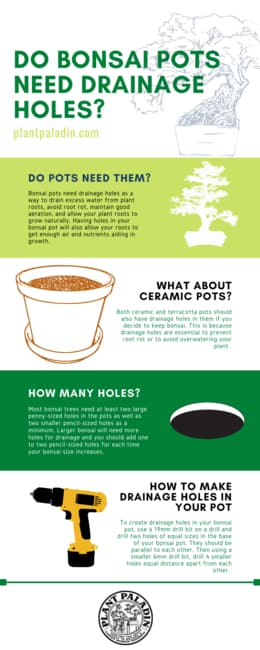
What are the disadvantages of having drainage holes
Having drainage holes is incredibly important for the overall health and success of your tree. That being said, I can think of two major disadvantages to having holes in your bonsai pots.
These include:
- Insect infestations
- Having too many holes
Let’s explore these below:
Insect infestations
Something all bonsai owners will have to manage at some point in their bonsai career is the influx of insect infestations during the warmer summer months,
Aphids, whiteflies, scale, and a myriad of other creepy crawlies are commonplace, especially if you keep your bonsai outdoors.
Having more holes than in the base of your bonsai pot will mean it is much easier for certain bugs to enter your bonsai and lay eggs.
Whilst this is a very real problem I don’t think a good option here would be to avoid drainage holes altogether.
Instead regularly inspect your bonsai (at least once per week), for signs of insect infestations and use natural pesticides such as neem oil to remove these pets,
Now, this is a topic all unto itself so to help – check out my post on how to get rid of bugs from your bonsai tree.
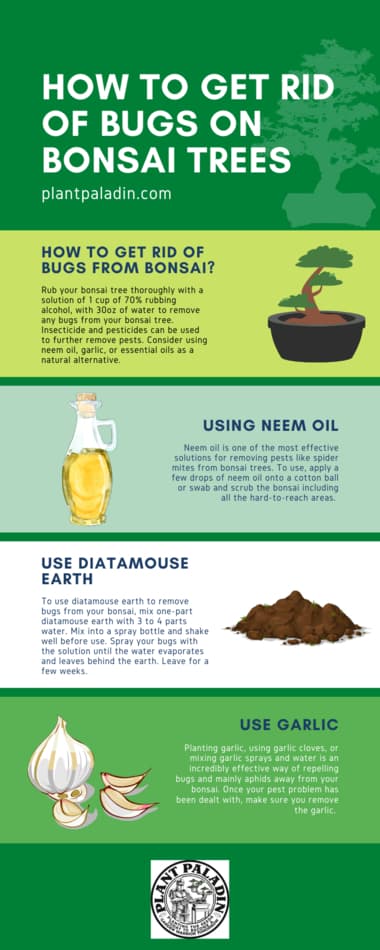
Having too many drainage holes
Another common problem some people have with drainage holes in bonsai pots is simply having too many of them.
I mean let’s face it if you have a fingertip bonsai that has 50 small holes in your pot you might be overdoing it.
Having too many holes in your bonsai can cause the valuable nutrients in your fertilizer or water that your bonsai craves to seep out. This can cause your bonsai soil to become dry making it more difficult for your bonsai roots to stay healthy.
Should ceramic bonsai pots have drainage holes too?
So for most of you reading this, a lot of what we have covered will have made sense.
A lot of us keep our bonsai in standard plastic pots that already have pre-built drainage holes in them so we don’t have to worry about it.
But what about ceramic pots?
After all, these are usually a lot more aesthetically pleasing than traditional plastic pots and so are much more commonly used for bonsai.
Both ceramic and terracotta pots should also have drainage holes in them if you decide to keep bonsai. This is because drainage holes are essential to prevent root rot or to avoid overwatering your plant.
The salt build-up in pots
Now while having holes in your pot will help address a lot of the problems it will also help avoid salt build-up.
You see if you are using a terracotta or ceramic plant pot for your bonsai that does not have a drainage hole, this can easily lead to an excess build-up of salt – leading to an unhealthy environment for your plants.
It’s also worth noting that even if you do not have a bonsai tree as of yet, all plants with the exception of a few aquatic species need holes in the pots that are kept in to avoid any of the problems laid out in this post.
How many drainage holes do bonsai trees need?
So if you have decided that you need to repot your bonsai tree to a pot with drainage holes, the biggest question we now have to ask is how many drainage holes do bonsai plant pots need?
Most bonsai trees need at least two large 19mm penny-sized holes in the pots as well as two smaller 6mm pencil-sized holes as a minimum. Larger bonsai will need more holes for drainage and you should add one to two pencil-sized holes for each time your bonsai size increases.
Should bonsai pots have large drainage holes or small drainage holes?
Now I appreciate that bonsai size classification and the number of holes per bonsai tree pot can be a tricky subject, but I’ve linked to a post earlier in this article that covers all aspects of bonsai sizes.
To help summarize though hopefully, the table below should help:
| Classification | Size inches | Number of penny-sized holes | Number of pencil-sized holes |
| Keshitsubo | 1 to 3 inches | 1-2 | 0 |
| Shito | 2 to 4 inches | 1-2 | 0 |
| Mame | 2 to 6 inches | 2 | 2 |
| Chohin | 5 to 8 inches | 2 | 2 |
| Kumono | 6 to 10 inches | 2 | 2 |
| Katade-mochi | 10 to 18 inches | 2 | 3 |
| Chiu or Chumono | 16 to 36 inches | 2 | 4 |
| Dai or Omono | 30 to 48 inches | 3 | 6 |
| Hachi-uye | 40 to 60 inches | 4 | 8 |
| Imperial | 60 to 80 inches | 6 | 8 |
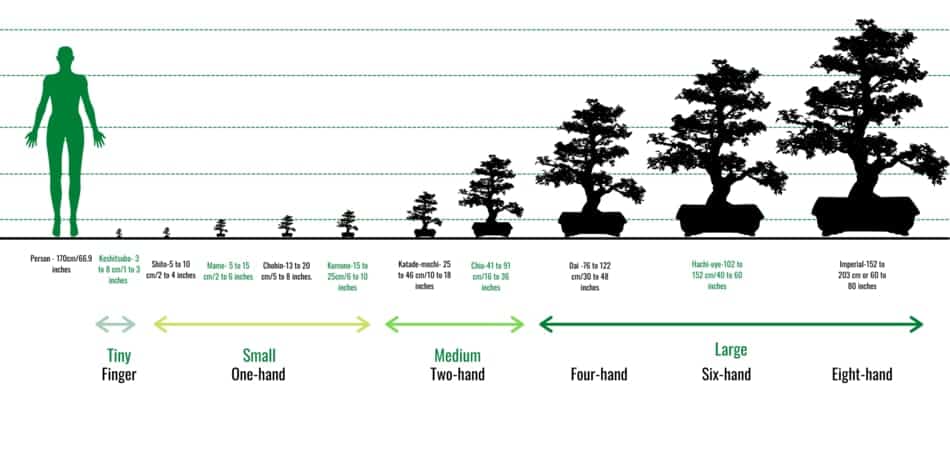
What is the right number of drainage holes to have for your tree?
It’s worth noting that the number of drainage holes will also depend on the individual species and the areas they reside.
For example, tropical species will likely need more watering and so will need more holes in their pots to drain.
Equally, plants that are from warmer climates such as succulent species will need a lot of holes in their pots in order to ensure they are not retaining too much water.
How to make drainage holes in your bonsai pot?
Now if you have already purchased your bonsai pots only to realize they don’t come with built-in holes you can DIY the method and make some yourself.
To create drainage holes in your bonsai pot, use a 19mm drill bit and drill two holes of equal sizes in the base of your bonsai pot. They should be parallel to each other. Then using a smaller 6mm drill bit, drill 4 smaller holes equal distance apart from each other.
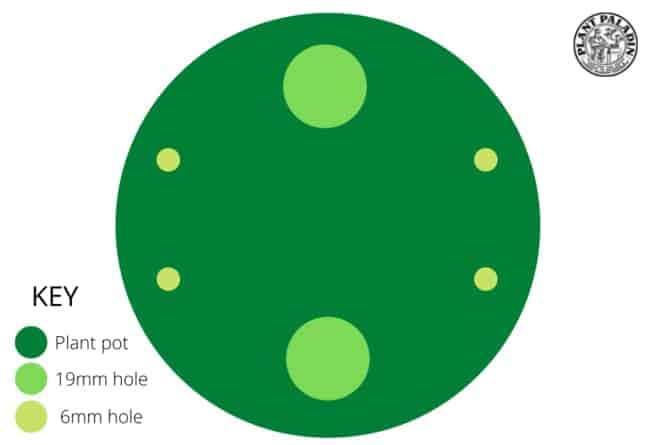
Why do bonsai pots need drainage holes?
Bonsai pots need drainage holes for a few key reasons that include:
- Ensure water and excess moisture passes through the plant
- Give enough aeration to allow plants roots to breath
- Allows the plant roots to grow unimpeded
What are some good bonsai plant pots with drainage holes?
Now if you are in the market for bonsai trees, luckily there are a few fantastic options.
First of all, Amazon has some fantastic options but my two pics would have to be:
- Happy Bonsai 6 to 8-inch set (link takes you to Amazon) – a fantastic choice that does not break the bank but has a beautiful traditional look to them.
- Geniely 3 pack (link takes you to Amazon) – Now if you don’t want to go for the traditional Japanese look for your bonsai then another good option would be the 3 pack from genuinely. They are super lightweight to use and come with built-in moisture trays.
Now I appreciate not everyone wants to go down the Amazon route and so if this is you my recommendation would have to be to check out Easternleaf who have a fantastic selection of pots that ship worldwide.
For my recommendation for Easternleaf I would have to go with the 5 inch dark teal round footed Shohin pot. I love the color of this one and the three feet really do make this pot stand out from standard designs. Just be aware that if your bonsai needs a pot bigger than 5 inches they have a huge selection.
My top picks for the gear you will need!
So like I mentioned earlier, over the past three years of running PlantPaladin, hundreds of people have asked me for my recommendations on the best bonsai gear on the market.
Having spent thousands of dollars on bonsai items these past few years and tested at least 100 bonsai-specific products, I’ve listed my favorite products below – All of which I highly recommend and think you can get great value.
They can purchase directly by clicking the link to take them to Amazon.
Bonsai Tool Set: One of the significant challenges I’ve had is finding a toolset that was not only durable but didn’t break the bank. SOLIGT has recently developed a fantastic bonsai tool set that covers all the tools you need to trim, prune, and repot your trees. – You can grab it here.
Complete Bonsai Set: Many of you will want to grow your bonsai trees entirely from scratch, but finding the varicose seeds, pots, and other items in one place can be challenging. Leaves and Sole then have created a complete bonsai set that I’ve personally used that ticks all the boxes. You can grab it here.
Bonsai wire: The number of times I’ve run out of wire for my bonsai or purchased cheap bonsai wire that doesn’t do the job is embarrassing for me to admit. After a lot of trial and error, I found that using Hotop’s aluminum bonsai wire is one of the best options on the market. This can easily be used for both indoor and outdoor bonsai. You can grab it here.
Fehed Nicass has been passionate about all things bonsai and botany focused for the past 3 years. What started out as a hobby has developed as a passion and he is now on a mission to teach and learn.
